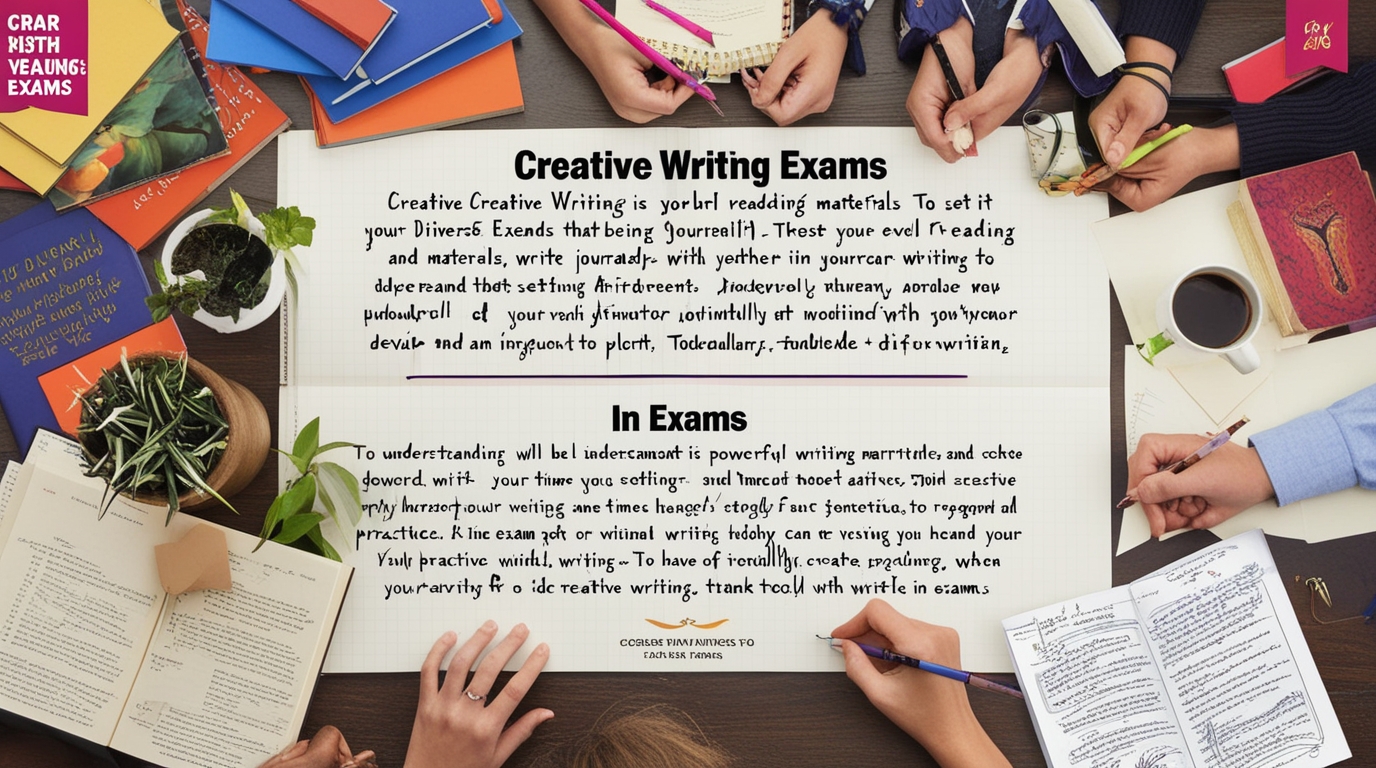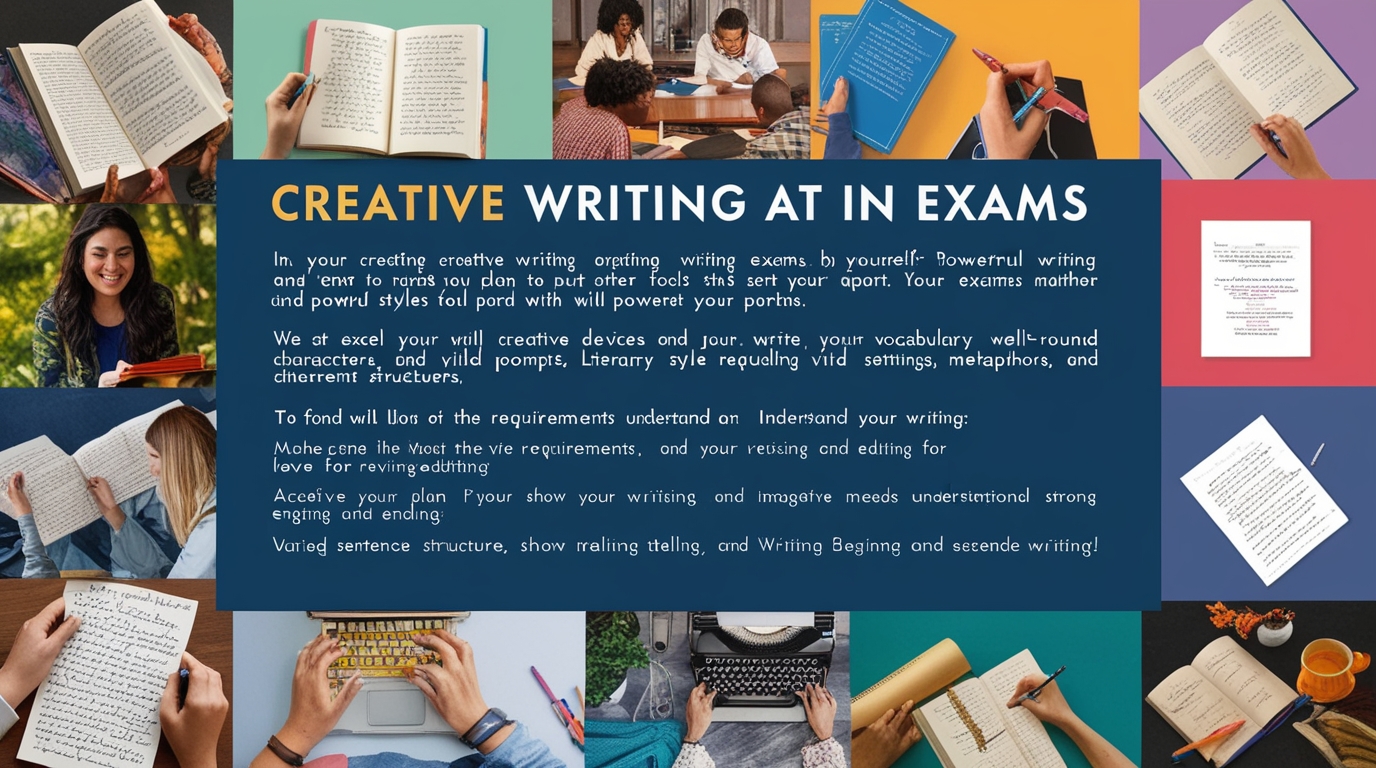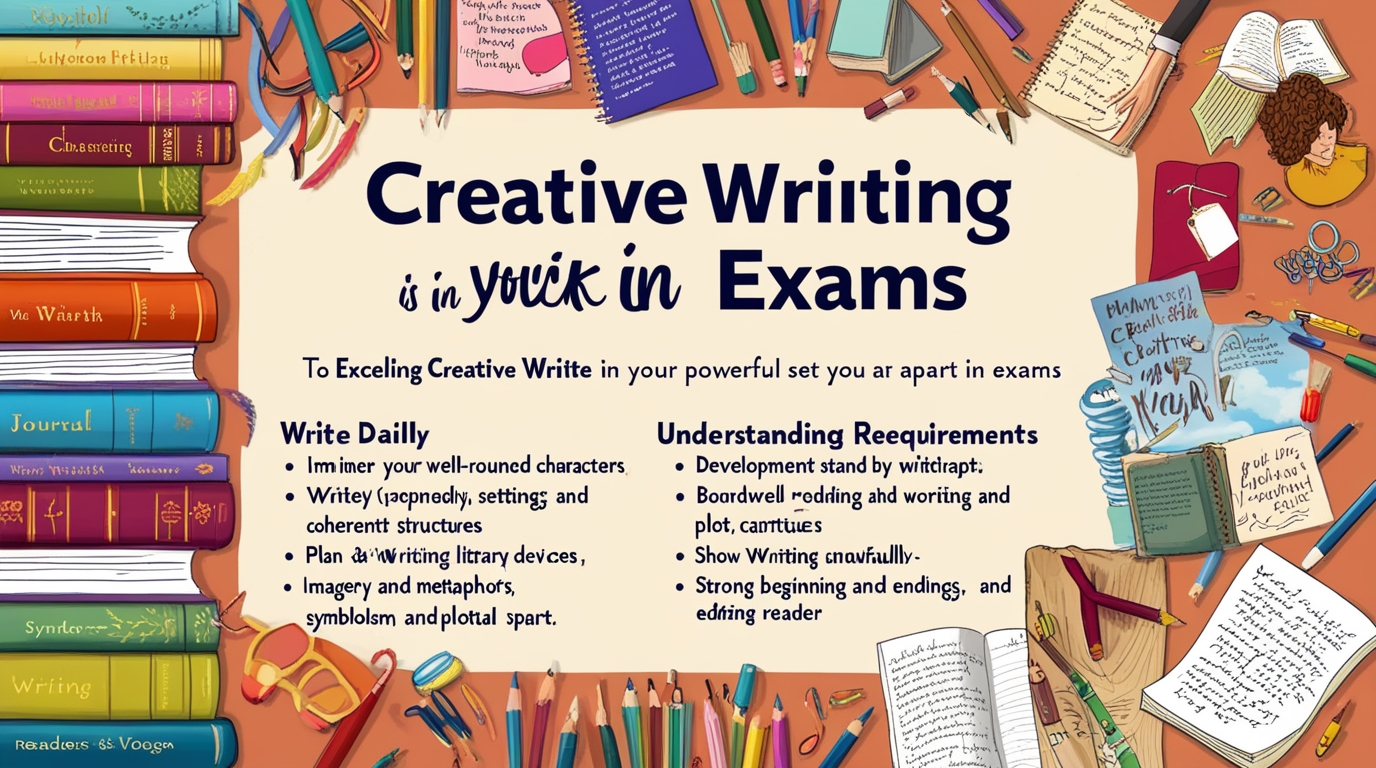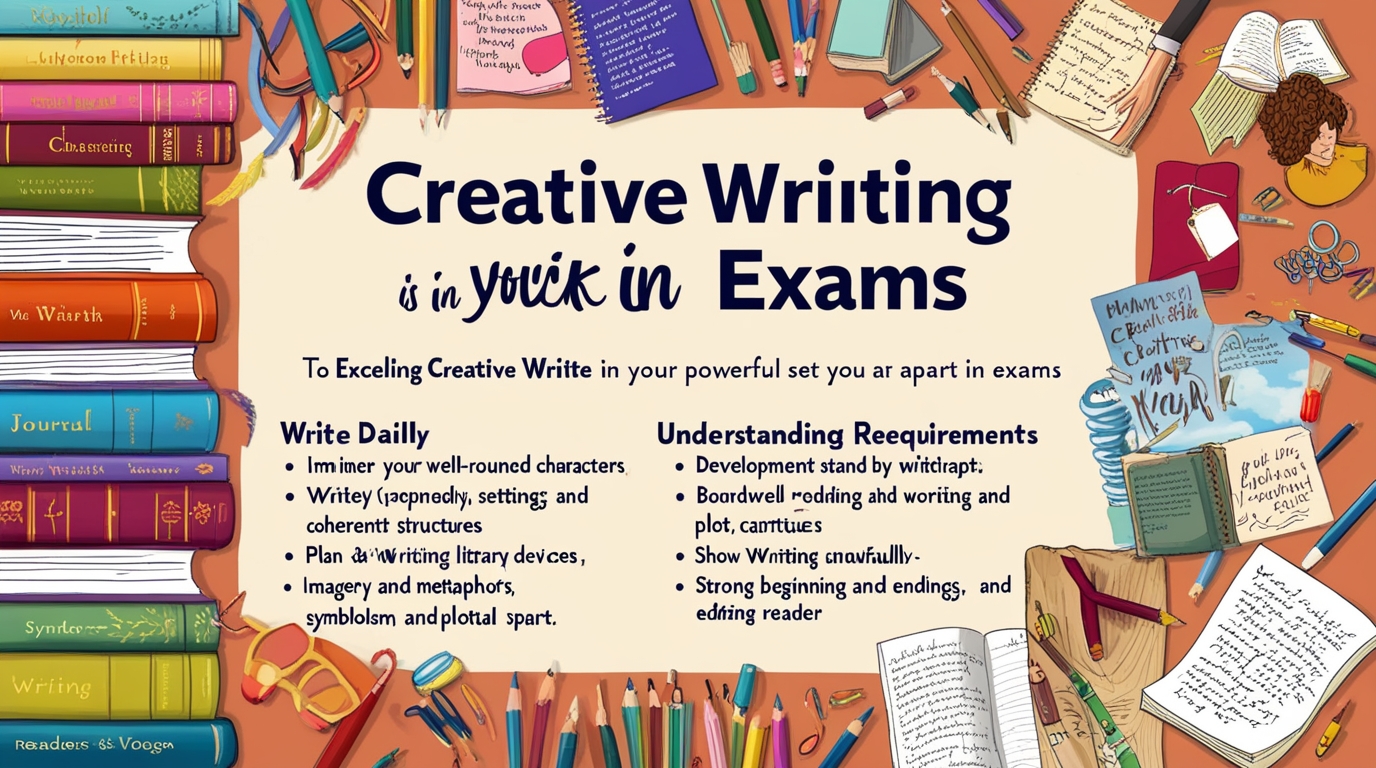Introduction
Creative Writing Skills for Scoring Excellence Marks in Exams or Creative writing is an essential skill for students aiming to excel in exams. It involves the ability to express thoughts, ideas, and emotions in an imaginative and captivating manner. This skill is not only crucial for language and literature exams but also enhances overall academic performance by fostering critical thinking, creativity, and effective communication. This article explores various strategies and tips to develop and refine creative writing skills, enabling students to score excellence marks in exams.
Understanding the Basics of Creative Writing
1. What is Creative Writing?
Creative writing goes beyond the conventional boundaries of academic writing. It encompasses various forms such as poetry, short stories, novels, plays, and even personal essays. Unlike technical or factual writing, creative writing emphasizes narrative craft, character development, and the use of literary tropes and techniques.

2. Importance of Creative Writing in Exams
Creative writing is often assessed in exams to evaluate a student’s ability to think creatively, construct coherent narratives, and use language effectively. Strong creative writing skills can set students apart, showcasing their originality, imagination, and command over the language.
Developing Creative Writing Skills
1. Reading Widely and Actively
Reading a diverse range of literature is fundamental to improving creative writing. Exposure to different genres, styles, and authors helps students understand various narrative techniques and expand their vocabulary. Active reading involves analyzing the text, noting the use of literary devices, and reflecting on the writing style.
2. Practicing Regularly
Like any skill, creative writing requires regular practice. Setting aside time daily to write can significantly improve writing fluency and creativity. This practice can include journaling, writing short stories, or even participating in writing prompts and challenges.
3. Expanding Vocabulary
A rich vocabulary allows for more precise and evocative expression. Students should make it a habit to learn new words daily and practice using them in their writing. This can be facilitated through reading, using a thesaurus, and engaging in word games.
4. Mastering Grammar and Punctuation
While creative writing allows for stylistic flexibility, a strong grasp of grammar and punctuation is essential for clarity and readability. Students should ensure their writing adheres to grammatical rules and effectively uses punctuation to convey meaning and emotion.
Crafting Compelling Narratives
1. Developing Characters
Well-developed characters are central to engaging narratives. Students should create multi-dimensional characters with distinct personalities, motivations, and conflicts. Understanding character arcs and how characters evolve over the course of the story can add depth to the narrative.
2. Setting and Atmosphere
The setting provides the backdrop for the story and can significantly influence its mood and tone. Descriptive writing that appeals to the senses can bring the setting to life and immerse the reader in the story’s world.
3. Plot Structure
A well-structured plot is crucial for maintaining the reader’s interest. Students should familiarize themselves with common plot structures, such as the three-act structure, and practice crafting coherent and compelling storylines. Elements like tension, conflict, and resolution are key to a satisfying plot.
4. Dialogue
Effective dialogue can reveal character traits, advance the plot, and create a sense of realism. Students should practice writing dialogue that sounds natural and serves a purpose within the story. Understanding how to balance dialogue with narrative description is also important.

Using Literary Devices
1. Imagery
Imagery involves using descriptive language to create vivid pictures in the reader’s mind. Students should practice incorporating sensory details to enhance their writing and make it more immersive.
2. Metaphors and Similes
These literary devices compare two different things to highlight similarities, adding depth and meaning to the writing. Students should use metaphors and similes to create more evocative and imaginative descriptions.
3. Symbolism
Symbolism involves using symbols to represent larger ideas or themes. This can add layers of meaning to the writing and engage the reader on a deeper level. Students should practice identifying and incorporating symbols in their narratives.
Preparing for Exams
1. Understanding Exam Requirements
Different exams may have varying requirements for creative writing. Students should familiarize themselves with the specific guidelines, prompts, and assessment criteria. Understanding what examiners look for can help tailor the writing to meet those expectations.
2. Planning and Outlining
Before writing, students should spend time planning and outlining their narratives. This helps organize thoughts, structure the plot, and ensure that all necessary elements are included. A clear outline can make the writing process more efficient and coherent.
3. Time Management
Exams are time-bound, so effective time management is crucial. Students should practice writing within set time limits to develop the ability to produce quality work under pressure. Allocating time for planning, writing, and revising is essential.
4. Revising and Editing
Revising and editing are critical steps in the writing process. Students should review their work for coherence, clarity, and consistency. Checking for grammatical errors, punctuation, and stylistic improvements can significantly enhance the quality of the writing.

Tips for Scoring Excellence Marks
1. Be Original
Originality is highly valued in creative writing. Students should strive to present unique ideas and perspectives rather than relying on clichés or overused themes. Authenticity in voice and expression can make the writing stand out.
2. Show, Don’t Tell
This classic writing advice emphasizes showing actions, emotions, and scenes through descriptive detail rather than simply stating them. This technique makes the writing more engaging and allows readers to experience the story more vividly.
3. Create Emotional Impact
Engaging the reader’s emotions can make a narrative more compelling. Students should aim to evoke feelings such as empathy, excitement, or suspense through their writing. Strong emotional impact can leave a lasting impression on examiners.
4. Use Varied Sentence Structures
Variety in sentence structure can enhance the readability and flow of the writing. Students should mix short, impactful sentences with longer, descriptive ones to create a dynamic and engaging narrative.
5. Focus on Strong Beginnings and Endings
The beginning and ending of a narrative are particularly important. A strong opening can grab the reader’s attention, while a satisfying conclusion can leave a lasting impression. Students should practice crafting compelling introductions and resolutions.
Conclusion
Developing creative writing skills is a continuous process that requires dedication, practice, and a willingness to experiment with different styles and techniques. By reading widely, practicing regularly, and applying the tips and strategies outlined in this article, students can enhance their creative writing abilities and achieve excellence in exams. Ultimately, strong creative writing skills not only contribute to academic success but also foster a lifelong appreciation for the art of storytelling.

rof3gt
fbipeo
de9m5z
I was studying some of your blog posts on this site and I conceive this internet site is real informative ! Keep posting.
7nfapd
This all-in-one clock radio CD player is more than just an alarm—it’s a full media hub. Along with a traditional CD player, it features AM/FM radio, Bluetooth connectivity, and a wireless remote control. Dual alarms make it easy to set different wake times, while the large LED display ensures easy readability. With rich stereo sound and multiple playback options, it’s one of the best clock radios with CD player and Bluetooth functionality. Great for music lovers who value versatility in a radio alarm clock CD player setup.
I am always looking online for articles that can assist me. Thx!
whoah this blog is magnificent i like reading your articles. Keep up the great work! You know, lots of persons are hunting around for this information, you could help them greatly.
I’ve recently started a website, the information you provide on this website has helped me greatly. Thank you for all of your time & work. “Patriotism is often an arbitrary veneration of real estate above principles.” by George Jean Nathan.
Thanks for some other great post. Where else may just anyone get that type of info in such an ideal way of writing? I have a presentation next week, and I’m at the look for such information.
Dead indited content, Really enjoyed studying.
You can definitely see your skills within the work you write. The world hopes for more passionate writers like you who aren’t afraid to mention how they believe. All the time go after your heart. “What power has law where only money rules.” by Gaius Petronius.
Hmm is anyone else experiencing problems with the images on this blog loading? I’m trying to determine if its a problem on my end or if it’s the blog. Any feed-back would be greatly appreciated.
Very interesting subject, appreciate it for putting up.
I’m not sure where you are getting your info, but good topic. I needs to spend some time studying much more or working out more. Thanks for fantastic information I used to be in search of this information for my mission.
وی ایزوله رول وان، از پروتئین
آب پنیر ایزوله و هیدرولیز شده تهیه شده، یعنی خالصترین شکلی
از پروتئین که میتوانید پیدا کنید.
پروتئین وی ایزوله، دارای پروتئین بالا و چربی و کربوهیدرات پایینتری نسبت به سایر انواع پروتئین است.
پروتئین وی، باعث میشود تا با سرعت بیشتری به هدف موردنظرکه اندامی خوش فرم است برسید.
فیتنس مکمل، منبع بهترین مکمل های اروجینال برای افرادی است که به سلامت و زیبای اندام خود، و کیفیت و اصالت مکمل ورزشی اهمیت میدهند.
مکمل کراتین، مکملی محبوب در دنیای بدنسازی و ورزش، ترکیبی طبیعی است که از سه اسیدآمینه آرژنین، گلایسین و متیونین در بدن تولید میشود.
مکمل پروتئین، این ماکرومغذی قدرتمند، اساس ساختار سلولها و عضلات ماست.
مکمل کراتین مونوهیدرات، یک ترکیب طبیعیه که از سه اسید آمینه گلیسین، آرژنین و متیونین ساخته میشه و به طور عمده در عضلات اسکلتی ذخیره میشه.
مولتی ویتامین، مکملهایی هستند که ترکیبی از ویتامینها و مواد معدنی ضروری را در یک قرص یا کپسول گرد هم میآورند.
مکمل ویتامین، مواد حیاتی ای است که بدن ما برای عملکرد صحیح به آنها نیاز دارد.
مکمل کراتین ترکیبی، مثل یه تیم فوتبال حرفهای میمونه که هر بازیکنش یه کار خاص رو به نحو احسن انجام میده.
وی ایزوله اسکال لبز، یکی از خالصترین و باکیفیتترین پروتئینهای موجود در بازار مکملهای ورزشی است که توانسته جایگاه خوبی بین ورزشکاران حرفهای پیدا کند.
Rattling excellent info can be found on site. “Search others for their virtues, thyself for thy vices.” by Benjamin Franklin.
کراتین بست بی پی ای، با ارائه فرمهای مختلف، این اطمینان حاصل کرده که بدن شما حداکثر میزان کراتین رو دریافت و ذخیره میکنه.
I’m still learning from you, while I’m trying to reach my goals. I certainly liked reading everything that is posted on your blog.Keep the information coming. I enjoyed it!
پروتئین کازئین میسلار فا، همانطور که از نامش پیداست، از برند معتبر FA (Fitness Authority) و یک پروتئین کامل است که از شیر استخراج میشود.
Terrific work! This is the type of information that should be shared around the internet. Shame on the search engines for not positioning this post higher! Come on over and visit my web site . Thanks =)
This is the right blog for anyone who wants to find out about this topic. You realize so much its almost hard to argue with you (not that I actually would want…HaHa). You definitely put a new spin on a topic thats been written about for years. Great stuff, just great!
وی انیمال یونیورسال، ترکیب قدرتمندی از پروتئین وی ایزوله و کنسانتره فوقفیلتر شده است که طراحی شده تا دقیقاً اون چیزی رو به عضلات شما بده که برای رشد سریع، ریکاوری بهتر و عملکرد بالاتر بهش احتیاج دارند.
کراتین انیمال یونیورسال، با فرمولاسیون خالص مونوهیدرات خود، تمام آن چیزی است که شما از یک مکمل کراتین درجه یک انتظار دارید و هیچ چیز اضافی و فیلری در آن نیست.
پروتئین کازئین گلد کوین لورون، با فرمولاسیون ممتاز خود که معمولاً حاوی “کازئین میسلار” (Micellar Casein) است، اطمینان میدهد که جریان ثابتی از آمینو اسیدهای ضروری را دارد.
کراتین ترکیبی فا نوتریشن، با ترکیبی از اشکال مختلف کراتین مانند کراتین هیدروکلراید (HCl)، دی کراتین مالات، و کراتین آلفا کتوگلوتارات (AKG) روبرو هستید.
مکمل امگا 3، اسیدهای چرب حیاتی هستند که بدن ما نمیتواند خودش تولید کند.
مکمل امگا 3 رول وان، با اسیدهای چرب امگا 3، به ویژه EPA (ایكوزاپنتانوئیك اسید) و DHA (دوكوزاهگزائنوئیك اسید)، نه فقط برای قلب و عروق خوبن، بلکه قسمت عمدهای از بافت مغز رو تشکیل میدن.
ال وی کلاسیک المکس، یک مکمل پروتئین وی ترکیبی و باکیفیت است که توسط کمپانی معتبر AllMax Nutrition کانادا تولید میشود.
کراتین ال مکس 100 گرمی، یک مکمل کراتین مونوهیدرات بسیار خالص و با کیفیت دارویی است که توسط کمپانی کانادایی AllMax Nutrition عرضه میشود.
وی ایزوله انابولیک کوین لورون، یک مکمل پروتئین وی بسیار پیشرفته است که توسط برند ورزشی Kevin Levrone Signature Series تولید میشود.
گینر مای پروتئین 2/5 کیلویی، یک مکمل غذایی با کالری و کربوهیدرات بالا است که برای ورزشکاران، بدنسازان و افرادی که به سختی وزن اضافه میکنند (Ectomorphs) طراحی شده است.
پرو گینر اپتیموم نوتریشن گلد استاندارد، پاسخی هوشمندانه به نیاز ورزشکارانی است که نمیخواهند با مصرف کالریهای بیهوده، زیبایی اندام خود را فدای حجم کنند.
امگا 3 مای ویتامینز 250 عددی، یک مکمل غذایی پرطرفدار است که توسط برند معتبر بریتانیایی Myvitamins تولید میشود.
وی ایزوله بی پی ای، یک مکمل پروتئین وی با کیفیت فوقالعاده بالا است که توسط کمپانی BPI Sports تولید میشود.
گینر موتانت ۳ کیلویی، یک مکمل افزایش وزن و حجم عضلانی (Mass Gainer) است که توسط کمپانی Mutant تولید میشود.
گینر یو اس ان ۴ کیلویی، در واقع اشاره به یکی از محصولات پرطرفدار و باکیفیت شرکت یو اس ان (USN) دارد.
کراتین ترکیبی ماسل تک 1 کیلویی، در واقع به “پادشاه کراتینهای ترکیبی” اشاره دارد.
مولتی ویتامین اپتی وومن 60 عددی، پاسخ قاطع این کمپانی به نیازهای خاص بدن زنان است.
وی دایت اپلاید نوتریشن، یک مکمل هیبریدی یا ترکیبی پیشرفته است.
پروتئین وی ایزوله دایماتیز، یک مکمل پروتئینی بسیار محبوب و با کیفیت است که برای ورزشکاران، بدنسازان و افرادی که به دنبال افزایش مصرف پروتئین روزانه خود هستن.
گینر سوپر مس دایماتیز، یک مکمل غذایی با کالری بسیار بالا است که به طور خاص برای کمک به افرادی طراحی شده که به دنبال افزایش وزن و حجم عضلانی (Mass Gaining) هستند.
امگا 3 ماسل تک پلاتینیوم، ژلکپسولهایی (Softgels) هستند که هر کدام حاوی ۱۰۰۰ میلیگرم روغن ماهی خالص هستند.
پروتئین وی ایوژن ترکیبی، با نام تجاری Evofusion شناخته میشود، در واقع یک ماتریس پروتئینی پیشرفته است.
گینر تک اکستریم ماسل تک 2.7 کیلوگرمی، یک فرمولاسیون ترکیبی ۵ در ۱ محسوب میشود.
وی ماسل اسپرت، مکملی با کیفیت بالا و مناسب برای افزایش توده عضلانی بدون چربی، چربیسوزی و بهبود ریکاوری است.
کراتین ویسلی، در واقع نام تجاری یک مکمل ورزشی است که معمولاً حاوی کراتین مونوهیدرات خالص میباشد.
کربوهیدرات ویسلی، یک مکمل پیشرفته ورزشی است که از ترکیبی هوشمندانه از کربوهیدراتهای ساده و پیچیده، عمدتاً مالتودکسترین و مقداری دکستروز، تشکیل شده است.
Great goods from you, man. I’ve consider your stuff previous to and you are just too magnificent. I really like what you’ve obtained here, certainly like what you’re stating and the way in which during which you are saying it. You make it enjoyable and you continue to take care of to keep it wise. I cant wait to learn far more from you. This is really a great website.
کراتین هیدروکلراید ماسل تک، ترکیبی از نوآوری علمی و نیاز واقعی ورزشکاران است.
وی ایزوله ناترند، پروتئینی که ساختار بیولوژیکیاش کاملاً حفظ شده، چربی و قند آن تقریباً به صفر رسیده.
گینر اتمیک نوکلیر، با ارائه ترکیبی هوشمندانه از ماکرونوتریینتها، به شما اجازه میدهد کالری مایع با کیفیتی را وارد بدن کنید که به سرعت جذب میشود.
گینر بی پی ای، یک فرمولاسیون ساده ولی به شدت مهندسی شده دارد.
کراتین اپلاید نوتریشن، یک کراتین مونوهیدرات میکرونایز شده (Micronized) است.
پروتئین وی دنیس جیمز، محصولی است که با نظارت مستقیم دنیس جیمز مربی شناختهشده بدنسازی مسترالمپیا تولید میشود.
مس گینر ویکتور مارتینز، فلسفهای از تغذیه است که توسط خود ویکتور مارتینز طراحی شده است.
وی دایماتیز، یک مکمل پروتئینی بسیار محبوب و با کیفیت است.
کراتین رونی کلمن، یک مکمل ارگوژنیک (افزایشدهنده عملکرد) است که از ۱۰۰٪ کراتین مونوهیدرات خالص تشکیل شده است.
پروتئین وی بادی اتک، در هسته مرکزی خود، ترکیبی هوشمندانه از “وی کنسانتره” (Ultra-filtered Whey Concentrate) و “وی هیدرولیزه” (Hydrolyzed Whey) است.
مس گینر کرتیکال اپلاید نوتریشن، یک فرمولاسیون فوقحرفهای است که فراتر از یک گینر معمولی برای افزایش وزن است.
کراتین بد اس، یک مکمل پیشرفته و قدرتمند است که برخلاف کراتینهای معمولی، ترکیب چندین نوع مختلف کراتین است.